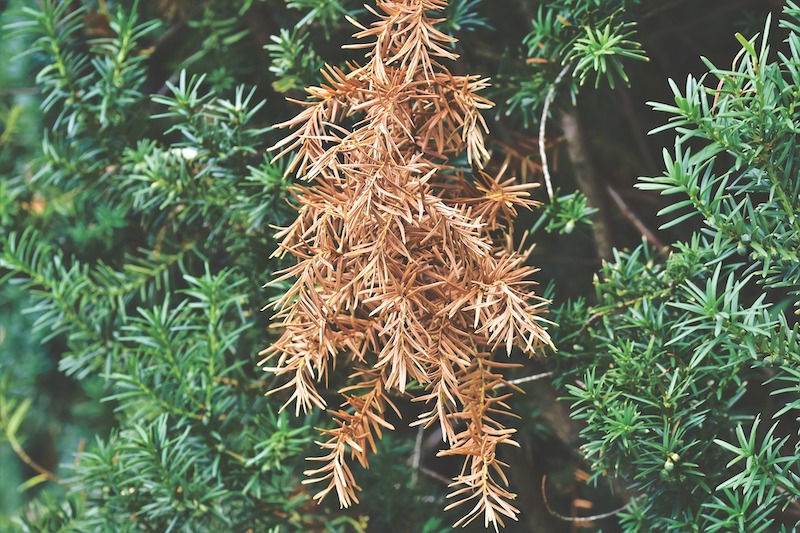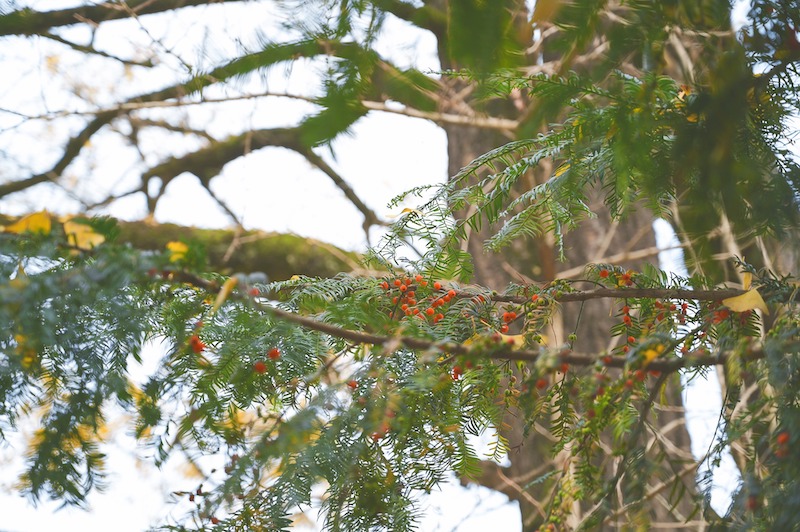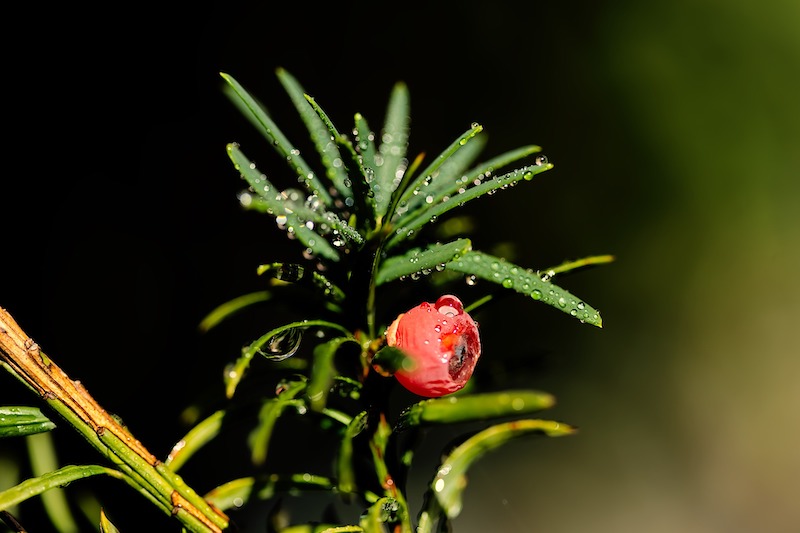Yews are generally quite tough and easy to grow, especially if proper care techniques are observed. However, a handful of different diseases may occasionally plague yews, members of the Taxus genus. These disease-resistant plants are often bothered by diseases when a site is less than ideal, such as when the yew is planted in a spot with poor soil drainage. Unless a yew is in a position of great importance in the landscape or severely infected, simply adjusting care practices a little can often adequately improve the situation.
The most common diseases or environmental disorders affecting yews in the landscape are needle blight and edema. The latter is a result of excessive water around the roots but is often mistaken for a fungal infection. Needle blight rarely threatens the long-term health of yews and is most likely to pop up during humid, rainy spells and when yews are growing tightly in hedges or near a sprinkler irrigation system.
Less commonly, yews may suffer from root rot caused by the fungal-like pathogen Phytophthora, which mostly attacks water-logged yew roots. One final pathogen that grows on but does not directly attack yews is unsightly sooty mold.

Needle Blight
Needle blight, rarely a serious concern for yews in the landscape, can still make yews unsightly and worry gardeners. Multiple species of fungi can cause needle blight. The fungal pathogen infects needles, causing discoloration and eventually needle drop. Humid conditions encourage disease development. Generally, proper care practices reduce the presence and impact of needle blight fungi on yew. Yews that are grown densely as a hedge or within reach of a sprinkler irrigation system are most likely to develop this fungal issue.
Identifying Needle Blight
Needle blight occurs as light spots, bands, or overall discoloration of needles. The needles will eventually turn brown, acquire small, dark, fruiting bodies, and fall off of the plant. Depending on the specific fungus, the affected needles may be from the current season of growth or the previous season..
Treating Needle Blight
Where needle blight is present, carefully prune out infected portions of the plant during dry weather, rake out and destroy fallen needles, and avoid overhead irrigation. Where infection is severe or the plant is in an important, high-visibility location, an application of a copper-containing fungicide labeled for use on evergreens is justified. Plants under stress are more prone to infection, so proper watering, light fertilizing in spring, and pruning for plant health will all minimize the potential for needle blight.

Edema
While not a true disease caused by a bacterial, fungal, or viral pathogen, edema is a common issue that affects yews throughout landscapes. This physiological disorder results from problematic environmental conditions. Edema is caused when plant cells, with their rigid walls, rupture because the plant has taken up more water than it needs. Essentially, the plant is drowning because of excessive irrigation or rainfall or poorly drained soils. Without remedying the situation, the yew can eventually decline and die.
Identifying Edema
Edema appears on yews as bumps on the undersides of needles. These bumps or blisters, the result of ruptured cells, eventually turn tan and corky. The bumpy edema is frequently accompanied by needle discoloration and death.
Treating Edema
Treat edema by doing whatever is possible to reduce the amount of moisture in the soil around the yew roots. This can be as simple as adjusting watering practices or redirecting downspout runoff. In areas where soil is poorly draining, like low spots or when there is a high clay content, improve drainage prior to planting to minimize the risk of wet feet for the yew. Work ample organic matter into clayey soils, add a drain pipe, or plant the yew root ball a few inches above the surrounding soil.

Root Rot
Root or crown rot, typically caused in yews by a pathogen like Phytophthora, is a potentially serious disease affecting yews and other landscape plants. Phytophthora species can survive in soil for years and can spread via contaminated equipment, soil, and plant material. Even when present in a landscape, this pathogen typically only infects plants that are subjected to high soil moisture or poor drainage. Left untreated and in poorly drained soil, an infected yew will languish, be prone to infection by other diseases, and eventually die.
Identifying Root Rot
An infection in a yew may not be noticeable until the disease has progressed significantly. The first aboveground symptoms include needle discoloration and drop and twig dieback. The entire plant may gradually decline and eventually die. Root symptoms appear first, with brownish lesions on small roots. Roots become black and brittle, but are frequently infected by secondary pathogens that make roots mushy.
Treating Root Rot
Adjusting irrigation practices, drainage and proper care practices will slow the advancement of disease or infection. The fungicide fosetyl-al can help to prevent infection. Treatments like this may be most beneficial in areas where old yews have likely suffered from root rot in the past and infection of newly planted specimens is feared. To prevent problems with root rot, make sure drainage is excellent prior to planting, amend soil as needed to improve drainage, thoroughly inspect any new plants for signs of root disease, and only use compost or soil from a reliable source.
Sooty Mold
Sooty mold is not a disease that feeds directly on a yew, but affects the appearance of a yew nonetheless. Sooty mold actually grows on honeydew, the sugary, shiny substance that pests like scale and mealybugs excrete as a byproduct of feeding. So, sooty mold is often an indicator of another issue that must be addressed. In small amounts it will not affect yew health significantly. However, when sooty mold growth is rampant, it can be unsightly and affect the yew’s ability to photosynthesize.
Identifying Sooty Mold
Sooty mold appears as a gray, brown, or black, soot-like fungal growth on needles and twigs. It grows on the sticky, shiny excrement from insects that are bothering the yew. If the yew is growing under the canopy of another plant, insects feeding on the taller plant may be dripping honeydew onto the yew. You may notice symptoms of feeding by the problem insect.
Treating Sooty Mold
Treatment of sooty mold itself is typically not the best course of action. Instead, focus on the pest source of the honeydew. Sooty mold will eventually disappear over time after the source of honeydew is addressed. It is possible to physically rinse honeydew and sooty mold off of yews and other plants. This, in conjunction with addressing the pest issue, is a great option for rescuing highly visible, prized specimens.
Yew Disease Chart
|
Disease |
Identifying |
Treating |
|
Needle blight |
Needle discoloration and drop |
Rake up needles, fungicide |
|
Sooty Molds |
Sooty surface covering |
Manage pests |
|
Edema |
Dark spots on leaves |
Improve soil drainage |
|
Root Rot |
Root symptoms, plant decline |
Improve soil drainage |
Sources: "What's Wrong With My Yew?" The University of Tennessee Institute of Agriculture. soillab.tennessee.edu
 |
Author Angela Ryczkowski - Published 4-15-2023 |
